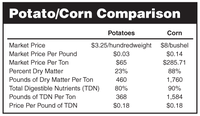Potatoes Possible Source of Cattle Feed
(Click the image below to view a high-resolution image that can be downloaded)
This year’s drought conditions may result in potatoes becoming a source of feed for cattle.
Dry weather before and during the 2012 growing season led to poor forage yields and high hay and corn prices, so beef producers will be looking for other, lower-priced feed sources, says Carl Dahlen, North Dakota State University Extension Service beef cattle specialist. Byproduct feeds such as distillers grain may be limited and higher priced as well because many producers have secured contracts for byproducts, leaving processing plants with little surplus for other producers.
Also, a 5 percent increase in acres of potatoes planted in North Dakota and nationally has resulted in a larger supply of potatoes and a low market price, according to Andrew Robinson, an NDSU Extension agronomist specializing in potatoes.
The dry weather has led to an increase in disease and malformation in potatoes, which means the number of cull potatoes likely will be higher because the potatoes no longer are marketable to the fresh markets or for processing.
Potato warehouses often discard potatoes that can’t be marketed, dumping them onto fields as a way to dispose of them. Cattle producers may find a low-cost feedstuff if they contact potato warehouses about purchasing the culled potatoes, Dahlen says. Potato processing plants also may be a good source of livestock feed.
Here are a few factors producers need to consider when deciding whether to feed their cattle potatoes:
- Potatoes’ quality as feed is similar to barley on a dry-matter basis.
- Potatoes are 70 to 80 percent water; therefore, the cost of transporting them on a dry-matter basis is high.
- Sprouted or sunburned potatoes can contain compounds (glycoalkaloids) that are poisonous to cattle. Sprouts, which are most likely a problem in the spring, should be removed.
- To ensile the potatoes successfully at a dry-matter content of about 60 to 65 percent, producers will need to chop or slice the potatoes and add some type of dry feed (straw, hay, etc.).
- Potatoes can be freeze-dried by spreading them out in the winter and then fed the following spring/summer.
- Cattle may choke on potatoes, especially if they are frozen, so they should be chopped before they are fed to livestock.
- Cattle should be adapted to rations containing potatoes slowly to avoid digestive upsets.
When comparing different feed sources, a simple price per pound is not accurate, according to Ryan Larsen, an assistant professor in NDSU’s Agribusiness and Applied Economics Department. Some simple math helps compare feed based on price per energy content.
Potato growers and cattlemen also must consider the cost of digging the potatoes, trucking, slicing/chopping and mixing with straw or hay when determining the final price for the potatoes, Larsen says.
For information on possible sources of potatoes, contact Ted Kreis, marketing and communications director for the Northern Plains Potato Growers Association, at (218) 773-3633.
NDSU Agriculture Communication - Sept. 26, 2012
| Source: | Carl Dahlen, (701) 231-5588, carl.dahlen@ndsu.edu |
|---|---|
| Source: | Andrew Robinson, (701) 231-8732, andrew.p.robinson@ndsu.edu |
| Source: | Ryan Larsen, (701) 231-5747, ryan.larsen@ndsu.edu |
| Editor: | Ellen Crawford, (701) 231-5391, ellen.crawford@ndsu.edu |


